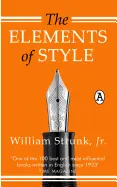
The Elements of Style - by William Strunk
ISBN: 9780205309023Date read: 2020-09-10
How strongly I recommend it: 2/10
(See my list of 430+ books, for more.)
Go to the Amazon page for details and reviews.
This book is legendary, but I learned so much more from “On Writing Well” by William Zinsser. That said, this book is very tiny, so maybe read it in an hour before reading “On Writing Well”, since that author references this book a few times.
my notes
Begin each paragraph with a topic sentence. End it in conformity with the beginning.
Enable the reader to discover the purpose of each paragraph.
The topic sentence comes at or near the beginning.
The succeeding sentences explain or establish or develop the statement made in the topic sentence.
The final sentence either emphasizes the thought of the topic sentence or states some important consequence.
Avoid ending with a digression or with an unimportant detail.
If the paragraph forms part of a larger composition, its relation to what precedes, or its function as a part of the whole, may need to be expressed.
This can sometimes be done by a mere word or phrase (again; therefore; for the same reason) in the topic sentence.
Sometimes, however, it is expedient to precede the topic sentence by one or more sentences of introduction or transition.
If more than one such sentence is required, it is generally better to set apart the transitional sentences as a separate paragraph.
According to the writer’s purpose, he may, as indicated above, relate the body of the paragraph to the topic sentence in one or more of several different ways.
He may make the meaning of the topic sentence clearer by restating it in other forms, by defining its terms, by denying the converse, by giving illustrations or specific instances.
He may establish it by proofs.
He may develop it by showing its implications and consequences.
Express a negative in positive form.
Express co-ordinate ideas in similar form.
Place the emphatic words of a sentence at the end.
Usually the logical predicate, that is, the new element in the sentence.
The principle that the proper place for what is to be made most prominent is the end applies equally to the words of a sentence, to the sentences of a paragraph, and to the paragraphs of a composition.
Less refers to quantity, fewer to number.